How to Make a Biscuit
How do you make a biscuit?

Biscuits are, in fact, the ideal food. My dad took this picture in September 2014.
I get this question a lot, mostly from friends who see me posting biscuits ad nauseum, and going on endlessly about how my biscuits are the superior biscuit. Maybe they think my biscuits look good, but maybe they just want to try my recipe and see how it stacks up, so they can ignore my evangelizing without FOMO.
How do you make a biscuit?
There are those who would tell you that to make a biscuit you need a rolling pin, and a biscuit cutter (or a pint glass will do!), those who tell you that biscuits need a full stick or more of butter. There are people who will tell you that biscuits can have cheese in them, or sugar (sorry yankees, if it has sugar it's a scone, that's the law). There are even people who put an egg wash, or a cream wash, on top of their biscuit. I have seen biscuits that call for cutting and then freezing the butter, before cutting it into the flour, and.biscuits that needed to be folded like puff pastry on chilled marble slabs.
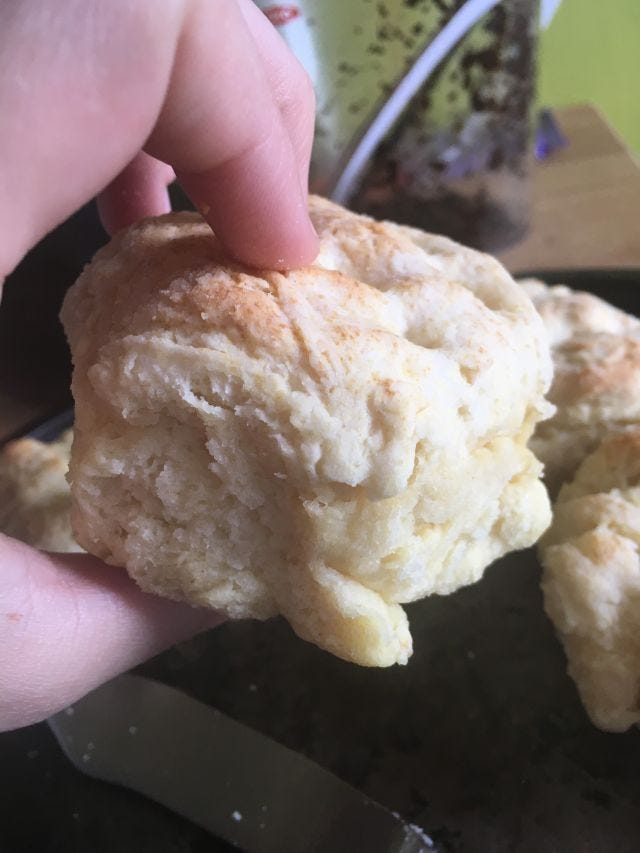
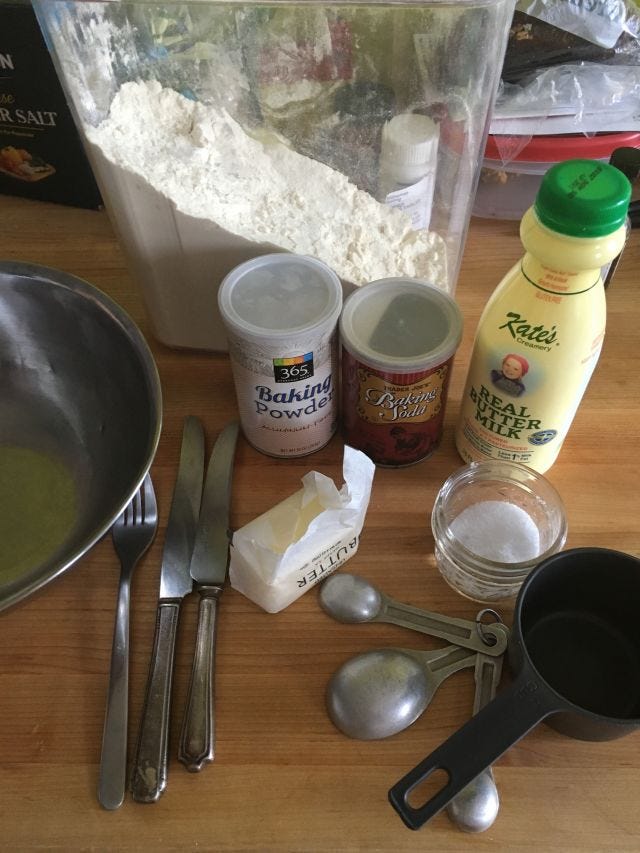
Left, a visual example of a biscuit. Right, the only tools necessary for making biscuits.
That is not how you make a biscuit.
When I make a biscuit I begin by meditating on all the things I have left behind. I cannot think about a biscuit without thinking about Saturday mornings in the kitchen at my parents' house. Waking up to the smell of them, and putting my feet on the cold floor as I bring myself into the kitchen and see my dad in his pajamas, and hear whatever music he had on. I remember the feeling of the dirty setee, and the smell of a dog, or two dogs, the feeling of them at your feet, or flinging themselves into your lap. I remember the look of bare trees out the window, and cold gray Georgia mornings. When I think about biscuits I think about sitting down at the sticky, badly varnished dining room table we had when I was a kid, and putting a slab of cheese in between the pieces of my biscuit. I think about my mom and I ragging on my dad for making (and eating) his repulsive sorghum and butter mash.
I think about the heritage of my biscuits—how they come from a recipe my dad made, without looking at a book, and how his would never taste like his mothers, and mine will never taste like his. I think about the grandmother I never knew—Peggy, whose cooking so influenced his. Peggy, I have heard, had a bowl of flour on her counter and she would make her biscuits in the bowl of flour, but not using all the flour, it would be just enough. How did she do that? I never met her, so I never got to ask, there are so many things that we never get to ask. There is a lineage of biscuitmaking, every southerner knows that this is true. The biscuits that we make may have the same ingredients but they will never feel the same as the ones we are trying to recreate.
How do you make a biscuit?
To really make a biscuit you have to practice for years. A biscuit gets its essential character not from buttermilk, or butter, or anything else, but by tradition, by being made by the feelings in your hands, not by the measurements in your cookbook. I used to try to make biscuits from recipes. I used to make these smitten kitchen biscuits, but they have far too much baking powder, which makes them dry and chalky in the mouth, and also too much butter, so overall they are too rich and excessively crumbly. Lots of people love these biscuits, because to them, a biscuit is just a vessel for eggs. A biscuit is a vessel for the past, a vessel for the best parts of tradition, not an egg, not jam, hell, not even cheese.
How do you make a biscuit? Well if you really want to know,
The first thing is you have to turn the oven on to 450. That's what you must do to start. Making biscuits is very fast, once you have made this recipe enough times you will be able to get them in the oven in about ten minutes (maybe less) so you really have to turn the oven on first.
Next, you get out your equipment. You will need: a set of measuring spoons, 1 cup measure, a largeish bowl, and two knives and a fork.
Measure two cups of flour into the bowl, add a pinch or two of salt (about a 1/4 tsp, this is my own innovation to the recipe, my dad never salted his), and 1 teaspoon baking powder and a half teaspoon baking soda. Mix it around with your fork. (don't put the flour away).
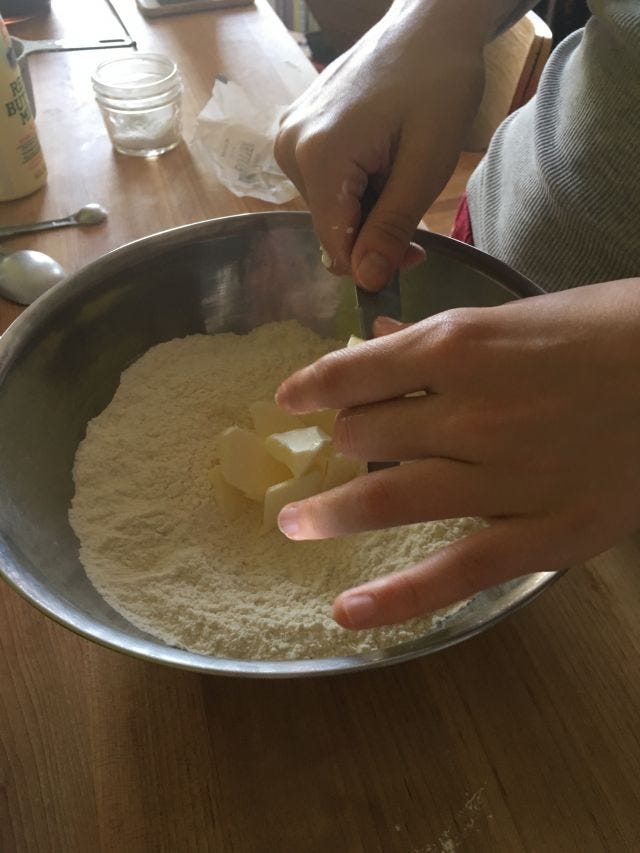
Get out your butter, and shortening if you use it (I use a mixture of butter and earth balance, or all butter, depending on what I have on hand, but you could do it with all earth balance and use soy milk with a splash of vinegar for a vegan biscuit). Cut in butter and/or shortening, about 6 tablespoons. You don't want it to be excessively buttery, but if you like a richer biscuit you can obviously add more butter, whatever.
Now, cut in the butter, and then once it is cut in put your hands in the mix. You want to rub the butter between your fingers, like you would if you were making a pie. You will rub it flat, to create little flakes. Don't go wild with it, but do try to incorporate all of it. No big chunks.
Take your fork and give it a stir again. Now, get your milk and buttermilk out of the refrigerator, or better yet, do like my dad would do, and holler for somebody who is lazing around not being useful to get it for you, because your hands will be messy, and this is a good way to indoctrinate people you love into biscuit culture.
Here is the tricky part. Make a well in the biscuit dough. Now, you will pour in some sweet milk (regular milk) and some buttermilk (or just all buttermilk, which is what I usually do, because I do not often have regular dairy milk at home) you want to pour enough in so that it splashes just over the side of your well. This is often about a cup, but a hair less. Being too reliant on the measurements here can be challenging, you just have to get a feel for it. Sometimes you get more flour in the cup than other times, so what is usually a perfect amount of liquid can yield sticky biscuits on an off day. When the dough feels right, it's right.
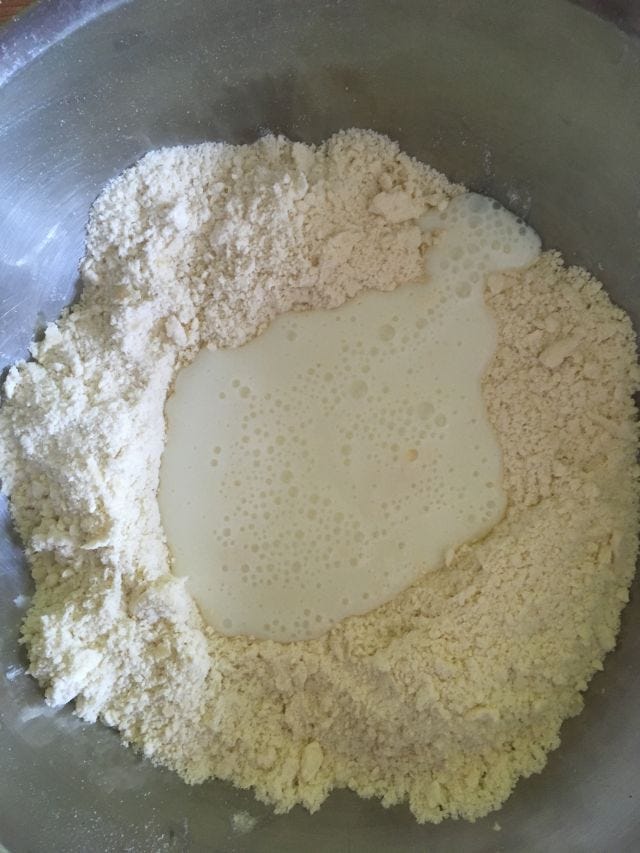

L is what it looks like when the fat is incorporated, and R is what it looks like when you've got about the right amount of buttermilk. Don't quote me on that though!
Take your fork, stir it until it's all incorporated. You don't want it to be wet and sticky, and you don't want it to be dry and chalky. How does the dough feel? That's what you have to think about here, does it cling to you when you slap it? Does it feel powdery? It should feel right. You'll get there eventually, mine is often still a bit too wet, I'm learning. Put a sparse handful of flour on the counter and put your biscuit dough on the flour. Knead it twice, maybe three times to make sure everything is mixed together well, and it's the right consistency. Now, get your biscuit pan, and tear off a hunk of dough. You can make biscuits whatever size you want, it doesn't matter. I typically go for a biscuit a bit smaller than my fist. Take your wad of dough, roll it into something like a ball (really, don't be particular) put it in the middle of your pan, and do that again with some new dough, each of the biscuit balls should be touching. This is important. Once you have all your biscuits together on the pan, press two knuckles down into each biscuit to give it a nice indentation. Once you've done that for all of them, you're done. Stick them in the oven. They cook for AROUND 11 minutes, but just keep an eye on them, you want them golden on top, if they are the right consistency when they go in the oven they will have a moderately smooth top when they come out.
When I was growing up we'd usually each have two biscuits for breakfast. We'd have our first course biscuit, which you make by cutting off a piece of cheese, and shoving it into a hollow you make in the biscuit right after it comes out of the oven. Then we'd have dessert biscuits. My mom and I would have our dessert biscuits with butter and honey, my dad would have his with sorghum. If you have never experienced Sorghum on a biscuit... it is a repulsive process. You take, I dunno, about a tablespoon of butter, stick it on your plate, then you get your jar of sorghum out from its hiding place and you pour an amount on top of the butter. Then you take your fork and mash it up. Once you have a sweetish sticky butter mash, you pile it onto your biscuit, and make a big ass show of how much you're enjoying it, just to gross out your family.
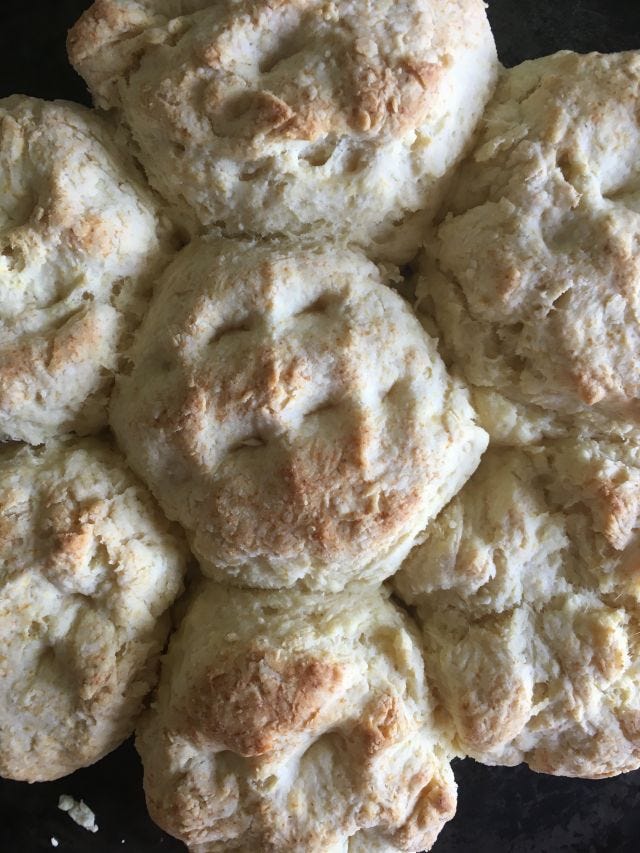
The Recipe:
Oh did you want something more concise? Okay... here's how you make a biscuit, according to my dad:
2 cups plain unbleached flour
2 teaspoons of baking POWDER*
1/4 tsp or two bigish pinches of salt
4-6 tablespoons of shortening(half and half butter/shortening, 4/2 -butter/shortening, all butter..however you want to do it
maybe about a cup of milk-enough to make the dough moist and moldable but not so sticky that it sticks all over your hands
You just have to get the feel for that part
*If you use baking SODA I would say use 1 tsp of POW#DER and 1/2 teasp of SODA
the amont of shortening is pretty flexible
Bake at 450
It is important to note about his recipe: if you are using buttermilk you need to use 1tsp powder and 1/2 tsp soda. The soda reacts with the buttermilk, yielding a better rise.
Well folks, that's what I've got for you this week. I haven't been cooking overmuch lately, I've been tired, and I'm about to go back to school, so I'm gonna be run ragged pretty soon. As always, I want to know, what are you making lately?
What did you learn to cook with your family? Was is biscuits? Was it something else? I'd love to hear about a recipe that you cook by feeling.

